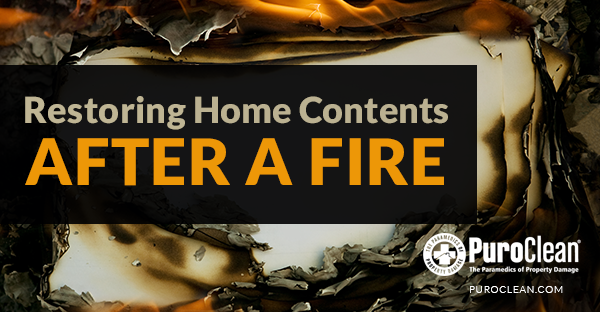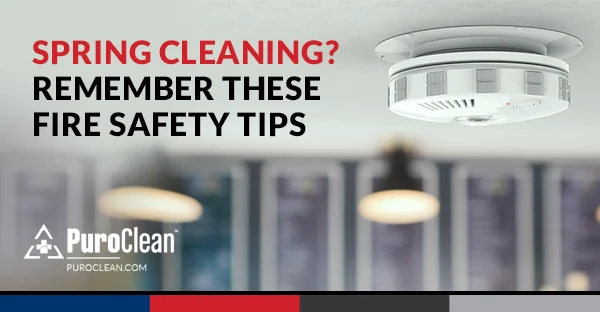Restoration of smoke and fire damage is very challenging. Every fire damage restoration job is unique in that each possesses distinct characteristics and challenges. For starters, each aspect of a fire creates a broad spectrum of variables that tests even the best of mitigation companies, including: the source of the fire, the intensity of the heat, the combustion rate, and the physical design and arrangement of the structure. When a fire breaks out, it immediately begins to change the environment of the structure. When the fire has sufficient fuel and has an adequate air supply, it consumes materials as it burns. The more flammable the fuel source, the more complete the consumption of the fire.
Products of Incomplete Combustion (PICs) are how professionals refer to the soot, residues, and remains of materials that could not be completely consumed by the fire. How much soot, how far it spread and how deeply it has penetrated is controlled by a number of factors.
HEAT is one variable that can highly affect the way in which restoration professionals mitigate the damage. The higher the heat, in most cases, the higher the rate of combustion and usually the richer the air was with oxygen during the fire. These are often known as “dry” fires. The products under combustion are more thoroughly consumed, and the intense heat results in a high degree of conversion from solid mass to energy—hot gases. If the materials are “natural” (wood, paper, cellulose, etc.), they are reduced to very dry soot (mostly the element, “carbon”) that is actually easier to remove than many other residues. The way these PICs are distributed and deposited allows the mitigation technician to first collect them with dry removal techniques such as vacuuming. Heat always causes expansion. Even surfaces that you would think would be easy to clean are now permeated with residues and odors.
OXYGEN rich environments allow for rapid combustion and high heat, consuming materials rapidly. So, if the fire is not put out quickly, the damage can be very devastating. Oxygen “poor” environments are a different situation all together. In this instance, the air does not have an “unlimited” oxygen source. Let’s suppose the fire was in a room that was isolated from the rest of the house by a closed door. Once the fire begins to consume materials in the room, it needs additional oxygen (air) to continue. If the open flame cannot obtain more oxygen, it begins to lose its ability to completely consume fuel sources. The result is a high percentage of Products of Incomplete Combustion. These are much “oilier” and much more difficult to remove. If the fuels being burned are not natural (i.e. plastics, etc.) then you add additional PICs in very high volume. The end result is a higher concentration of a smoke/soot residue. Because the temperature may not be as high as an oxygen rich fire, the difficulty of removal increases dramatically. Restoration professionals sometimes refer to these fires as “wet fires”. The resulting PICs smear when you try to clean them, and sealing before painting may be a required option.
CIRCULATION during a fire is one of the most interesting aspects. “Heat” moves toward “cold.” As areas begin to increase in temperature, they seek out cooler rooms and spaces. Heat is moving toward lower temperatures and seeking atmospheric equilibrium. Even if the heating and air conditioning system is not operating, the smoke/soot will still travel through-out the structure. High vapor pressure will “force” the residues into areas often viewed as begin “sealed.” It has even been found on items inside of a freezer. As air circulates it carries PICs and odor-charged molecules. This accounts for the need to clean and deodorize areas that are some distance from the source of the fire. As particles combust they become charged. In areas of low circulation they can form what is called “soot tags.” Fire damage customers are often under the impression that the smoke attached itself to spider webs they had prior to the fire. Quite the contrary—soot tags are new, unique chains of soot that gather in areas of low concentration.
ODORS from a fire also vary. When products in a fire burn, the odors join the oxygen molecule in the air we breathe. Undoubtedly, PICs create odor, but in some instances, the odor is quite strong even when the PICs are hard to find. Consider for instance, the common “I left a turkey in the oven and went to the store” fire. When the occupants returned, the odor of the burnt turkey is everywhere but there is very little soot. Here is the problem: the 20 pound bird is now 3 pounds of ash!
Q: Where did it go?
A: Everywhere! Even the clothes in the back closets contain odors indicating that protein fires are one of the most difficult to mitigate because of the pervasiveness of the odor. All odors have a source. The fire damage mitigation company must be persistent in seeking out all nooks and crannies to make sure that all smoke is removed and all surfaces deodorized. The very best solution to these problems is to call a trained, professional mitigation company to address these issues. They have the trained personnel and the professional equipment and products to provide excellent cleaning and odor control processes.
Look for a professional company that:
- Conducts all of their work in accordance with industry standards.
- Uses only professional equipment, products and tools.
- Has trained and certified employees.
- Has full insurance coverage.
- Has built-in accountability—(i.e. is a member of a franchise system, or otherwise has a dedicated quality assurance support team.)
Successful mitigation and restoration of a fire depends primarily on having trained professionals to provide these services. Contact your local PuroClean office for 24/7 emergency service provided by professional, well-trained technicians specializing in fire and smoke-related property damages.




 PuroClean of Deer Valley
PuroClean of Deer Valley